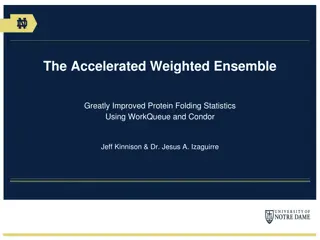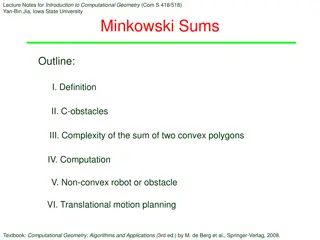Diffusion Weighted Imaging (DWI) in Neuroimaging Research
This content delves into the significance of Diffusion Weighted Imaging (DWI) in studying the motion of water molecules in brain tissue. It explains how water diffusion varies in different brain matter types and explores techniques like Diffusion Tensor Imaging (DTI). The impact factors on diffusion
4 views • 25 slides
Non-Weighted Codes and Excess-3 Code in Binary Systems
Explore non-weighted binary codes like Excess-3 code, learn how to convert decimal numbers to XS-3 code, advantages and disadvantages of BCD codes, and steps to convert Excess-3 code to binary. Discover the intricacies of binary coding systems with practical examples.
6 views • 55 slides
Understanding Your GPA: Weighted vs. Unweighted, College Admission, and Scholarships
GPA, or Grade Point Average, plays a crucial role in college admission and scholarship opportunities. Understanding the difference between weighted and unweighted GPAs is essential. Weighted GPAs give more weight to advanced classes like AP and Dual Enrollment, impacting your overall GPA calculation
0 views • 11 slides
SHRA Performance Appraisal Policy Guidelines
The SHRA Performance Appraisal Policy outlines the performance cycle, expectations, responsibilities, calibration sessions, setting of expectations, weighted goals, and more. Employees are encouraged to actively participate, ask questions, and keep supervisors informed. Supervisors are expected to p
1 views • 39 slides
Primal-Dual Algorithms for Node-Weighted Network Design in Planar Graphs
This research explores primal-dual algorithms for node-weighted network design in planar graphs, focusing on feedback vertex set problems, flavors and toppings of FVS, FVS in general graphs, and FVS in planar graphs. The study delves into NP-hard problems, approximation algorithms, and previous rela
2 views • 17 slides
A Deep Dive into Neural Network Units and Language Models
Explore the fundamentals of neural network units in language models, discussing computation, weights, biases, and activations. Understand the essence of weighted sums in neural networks and the application of non-linear activation functions like sigmoid, tanh, and ReLU. Dive into the heart of neural
0 views • 81 slides
Weighted Moving Average Charts for Process Monitoring
Weighted moving average charts are powerful tools for detecting small shifts and trends in process means. By utilizing Uniformly Weighted Moving Average (UWMA) charts and Exponentially Weighted Moving Average (EWMA) charts, organizations can monitor and identify changes in process means with precisi
1 views • 29 slides
Type I and Type III Sums of Squares in Experimental Design
Exploring the significance of Type I and Type III sums of squares in unbalanced experimental designs, highlighting the potential biases in treatment effect estimates and the differences in partitioning variation based on the order of terms entered in the model.
7 views • 26 slides
Noise & Error Shaping in Discrete-Time DSMs EECT 7V88 - Fall 2021
Explore the intricacies of noise and error shaping in DSMs with Professor Y. Chiu's course on Discrete-Time DSMs for EECT 7V88 in Fall 2021. Delve into DAC architectures including Nyquist, binary-weighted, and more. Learn about Binary-Weighted CR DAC, CP Cu, capacitor arrays, gain errors, nonlineari
5 views • 30 slides
The Cost of Capital in Finance
The cost of capital is crucial for businesses to determine the average cost of their finance. The Weighted Average Cost of Capital (WACC) is used as a discount rate in financial calculations. It involves estimating the cost of each source of finance and calculating a weighted average. Additionally,
0 views • 14 slides
Weighted Price Indices in Economics
Weighted price indices are essential in economics to measure changes in prices over time. Different methods such as Laspeyre's and Paasche's price indices offer ways to calculate these indices using weighted averages. Fisher's index combines both methods to provide a comprehensive view. The weighted
4 views • 9 slides
Decomposition of Treatment Sums of Squares
Decomposition of treatment sums of squares involves utilizing prior information about treatment structure to analyze treatment group means through contrasts and hypothesis testing. This process allows for the testing of specific hypotheses and the creation of F-statistics. In an example scenario wit
4 views • 12 slides
Sewing Club Making Weighted Bibs for Infants at MUSC Children's Hospital
Our Buist Sewing Club, inspired by the unity during the Bosnian War, creates weighted bibs for infants at MUSC Children's Hospital. These bibs provide comfort and aid in circulation post-surgery, benefitting over 137,000 children annually. Through our diverse group, we aim to make a positive impact
0 views • 15 slides
Eigenvalues in Quantum Information
Explore the eigenvalues of sums of non-commuting random symmetric matrices in the context of quantum information. Delve into the complexities of eigenvalue distributions in various scenarios, including random diagonals, orthogonal matrices, and symmetric matrix sums. Gain insights into classical and
1 views • 24 slides
School Finance: Key Funding Sources and Weighted Funding
Explore the differences in funding between charter schools and traditional ISDs, sources of funding in charter school systems, the impact of attendance on budget allocation, challenges in the Texas school finance system, and the future outlook for charter school funding amidst potential changes. Del
2 views • 90 slides
Effect of Weighted Sled Towing and Weighted Vest on Sprinter Acceleration Performance
Short distance running involves crucial phases affecting sprint performance, with acceleration being particularly important. Training methods like weighted sled towing and weighted vest usage have been found effective in enhancing sprint acceleration. This study investigated the impact of these meth
2 views • 8 slides
Sums of Powers of Positive Integers Through Leibnitz's Method
Students are introduced to the computation of sums of powers of positive integers through Leibnitz's Method and other techniques in the context of finding areas under curves and exploring integration. The presentation delves into the origins of these formulas and their computation, reflecting on the
1 views • 24 slides
Choosing Between Money-Weighted Return & Time-Weighted Return in CFA Level 1 Exam
Learn the differences and implications of Money-Weighted Return (MWRR) and Time-Weighted Return (TWRR) for your CFA Level 1 exam. Understand how to calculate these returns, their characteristics, and when each method is appropriate. Clear your calculator before computations, and remember the key tip
1 views • 12 slides
Risk Mitigation and Distribution in Trade Finance
Silja Calac and Paolo Carrozza discuss regulatory capital requirements, risk mitigation strategies in trade finance, and the impact of credit risk insurance on weighted assets. The comparison tables illustrate the benefits of insurance in reducing risk-weighted assets and regulatory capital.
0 views • 14 slides
Cost Variants in Healthy Diets: Least Cost vs Preference Weighted
The discussion delves into the concept of least-cost versus preference-weighted healthy diets, highlighting the differences in cost and food selection. It explores how preference weighting takes into account food preferences of low-income consumers, providing insights into the affordability and cult
0 views • 18 slides
New Extension of the Weil Bound for Character Sums
Tali Kaufman and Shachar Lovett present a new extension of the Weil bound for character sums, providing applications to coding theory. The Weil bound offers insights into the behavior of low-degree polynomials, distinguishing between structured and random-like functions. This extension has implicati
1 views • 28 slides
Weighted Average Cost Method in Accounting
The weighted average cost method is a crucial approach in valuing inventory for businesses. It calculates the average cost of all inventory items based on individual costs and quantities held in stock. By dividing the cost of goods available for sale by the number of units available, this method det
1 views • 5 slides
Accelerated Weighted Ensemble for Improved Protein Folding Statistics
The Accelerated Weighted Ensemble (AWE) approach addresses the challenges faced by traditional molecular dynamics (MD) simulations in generating statistically significant kinetic data for protein folding. By utilizing methods such as WorkQueue and Condor, AWE enhances efficiency and accuracy in stud
1 views • 14 slides
Area, Riemann Sums, and Definite Integrals
Antiderivatives are utilized to find area under curves, where Riemann Sums are employed for approximations. The process involves dividing intervals into rectangles for both approximate and exact area calculations. Definite integrals provide specific, finite values representing total displacement, wi
0 views • 8 slides
Integration and Antiderivatives
Exploring the concepts of definite and indefinite integrals, Riemann sums, and antiderivatives in calculus. Learn about interpreting the definite integral, Riemann sums as rectangles approximating integrals, and finding general antiderivatives. Discover various formulas for finding antiderivatives o
0 views • 16 slides
Exponentially Weighted Moving Average Control Charts
Exponentially Weighted Moving Average (EWMA) control charts offer an effective alternative to Shewhart control charts for detecting small shifts in processes. This article explores the definition, properties, and calculations involved in EWMA control charts, providing insights on using this method i
0 views • 28 slides
Capital Adequacy Ratio (CAR) in Banking
Capital Adequacy Ratio (CAR) is a crucial metric in banking that measures a bank's capital against its risk. Also known as CRAR, it enhances depositor protection and financial system stability worldwide. The CAR formula involves dividing a bank's capital by its risk-weighted assets, comprising tier
1 views • 7 slides
Systematic Design Evaluation and Optimization Methods
This content covers various structured design methods such as the V Model of Systems Engineering, Pugh Analysis, Weighted Objectives Method, and Ranking and Weighting Objectives. It also discusses the process of recognition, generation, evaluation, and optimization of design alternatives, along with
0 views • 15 slides
Graph Modeling in Data Structures and Algorithms
Exploring graph modeling in CSE 373, this lecture covers topics such as using BFS for finding shortest paths, limitations of BFS on weighted graphs, and the introduction of Dijkstra's algorithm for weighted graphs. It emphasizes the importance of considering edge weights in determining traversal ord
0 views • 29 slides
Riemann Sums and Area Approximations in Calculus
Explore the concepts of Riemann sums, different types of approximations like left, right, and midpoint sums, trapezoidal rule, and interpreting area in real-life scenarios with examples. Learn how to apply these methods to approximate irregular areas and calculate distances and average speeds. Dive
0 views • 6 slides
Versatile Tests for Comparing Survival Curves Based on Weighted Log-Rank Statistics
Overview of various statistical tests for comparing survival curves beyond the traditional log-rank test. The focus is on weighted log-rank statistics sensitive to non-proportional hazards scenarios, with examples and methodologies discussed. These tests aim to provide more nuanced insights into dif
0 views • 31 slides
Greedy Algorithms: Minimum Spanning Tree Analysis
Explore the concept of Minimum Spanning Tree (MST) in the context of greedy algorithms, focusing on Kruskal's Algorithm. Understand the methodology behind selecting the minimum weighted subgraph that connects all vertices in a weighted graph efficiently. Delve into problem-solving strategies and app
2 views • 39 slides
Dijkstra's Algorithm for Shortest Paths with Weighted Graphs
Dijkstra's Algorithm, named after inventor Edsger Dijkstra, is a fundamental concept in computer science for finding the shortest path in weighted graphs. By growing a set of nodes with computed shortest distances and efficiently using a priority queue, the algorithm adapts BFS to handle edge weight
0 views • 30 slides
Anytime Weighted MaxSAT with Improved Polarity Selection and Bit-Vector Optimization
Weighted MaxSAT is a optimization problem where targets are assigned weights and hard clauses must be satisfied. The goal is to find a model that maximizes the overall weight of satisfied target bits. The formulation involves unit clauses associated with integer weights, with a focus on improving po
0 views • 49 slides
Gas Exchange in Lung Function Using Density-Weighted MRSI
Advanced imaging techniques like Density-Weighted MRSI and Hyperpolarised 129Xe Gas play a crucial role in assessing lung function by detecting spatially resolved abnormalities. These methods are particularly valuable in conditions such as COPD, asthma, and idiopathic pulmonary fibrosis, as well as
0 views • 14 slides
Dynamic Computations in Ever-Changing Networks
Dynamic computations in ever-changing networks involve continuously adapting output to reflect input and environmental changes. This talk by Idit Keidar at TADDS Sep. 2011 explores the concept further, presenting examples like continuous weighted matching, live monitoring, and peer sampling. The dis
0 views • 51 slides
The Weighted Barycenter Drawing Recognition Problem
This study delves into the Weighted Barycenter Drawing Recognition Problem, focusing on characterizing force-directed layouts and computing weights for planar graph edges. With a background in the Weighted Barycenter Algorithm, the paper explores related work and presents results and conclusions fro
1 views • 16 slides
The Sieve of Eratosthenes and Prime Sums Exploration
Uncover the ancient mathematical algorithm of the Sieve of Eratosthenes and delve into exploring prime number sums. Dive into tutorials, Q&A sessions, and lab program details in this comprehensive recitation slide deck.
0 views • 28 slides
Dynamic Programming Explained: From Greedy Approaches to Weighted Interval Scheduling
Explore the concepts of dynamic programming in algorithms, from greedy approaches to weighted interval scheduling problems. Understand how dynamic programming efficiently solves complex problems by breaking them down into smaller, manageable subproblems. Learn about the similarities and differences
0 views • 22 slides
Computational Geometry Lecture Notes: Minkowski Sums and C-Obstacles Overview
Explore the definition, complexity, computation, and application of Minkowski Sums and C-obstacles in computational geometry with detailed examples and theorem proofs. Understand the concepts of translational motion planning and negation of sets for efficient algorithm design.
0 views • 23 slides







































